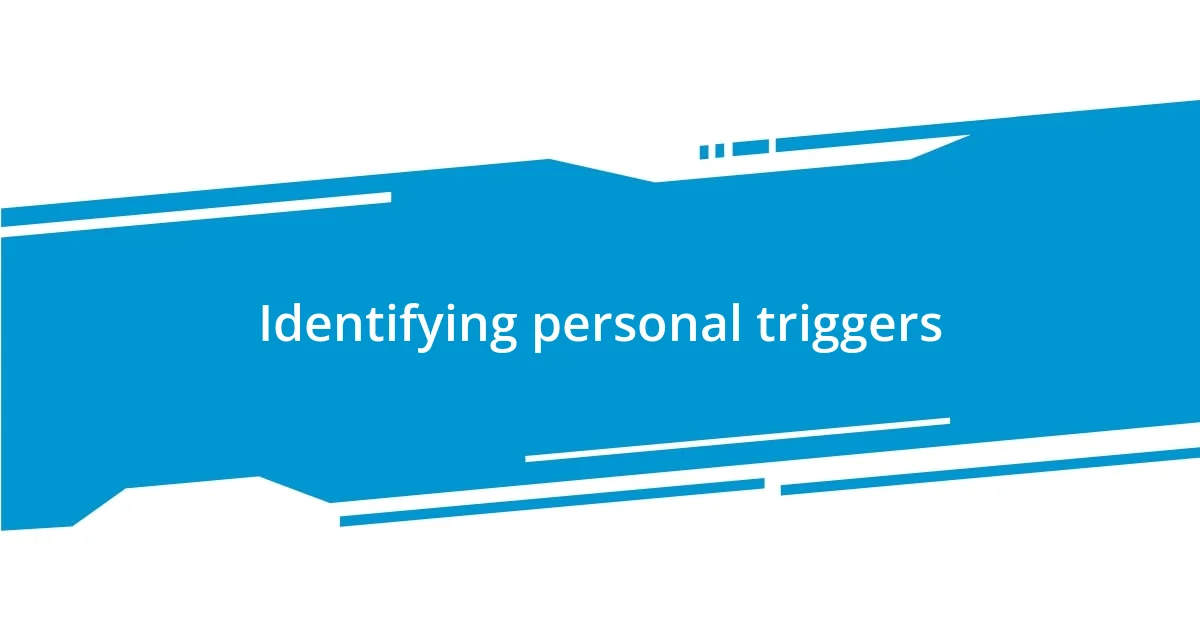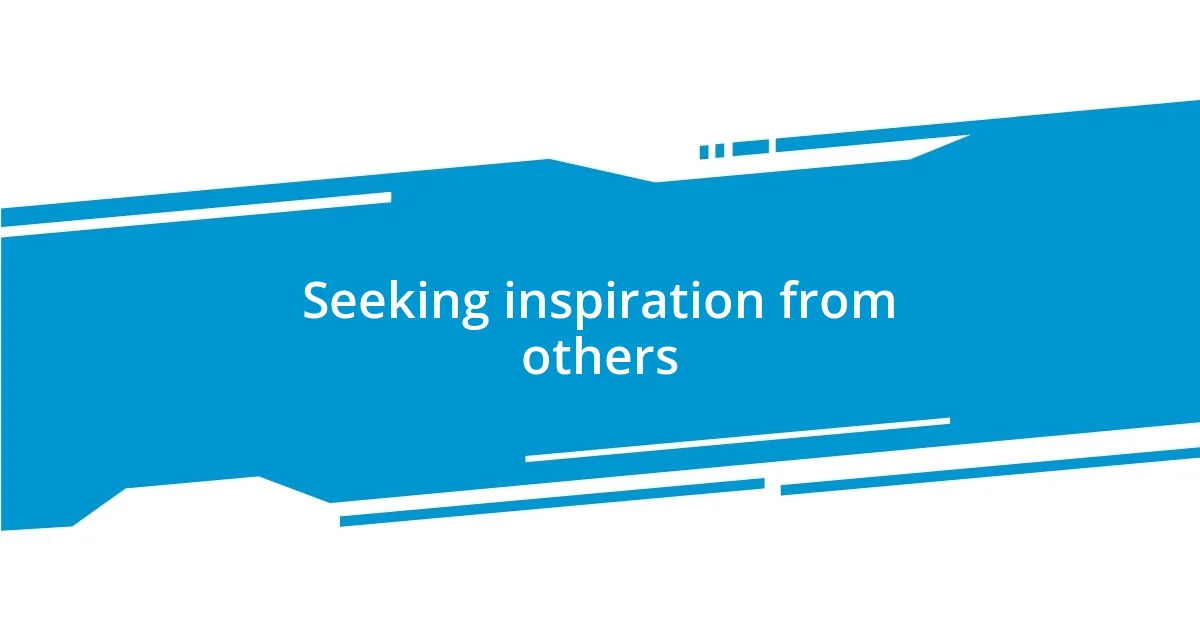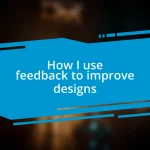Key takeaways:
- Recognizing and accepting creative block as a natural part of the creative process is essential for overcoming it.
- Establishing a consistent routine and engaging in design exercises can help reignite creativity and build confidence.
- Taking intentional breaks and reflecting on personal progress can enhance productivity and foster growth in the creative journey.

Understanding creative block
Creative block can feel like an invisible wall looming in front of you, preventing any ideas from flowing. I remember sitting in front of my sketchpad, pencil in hand, yet my mind was a swirling void. Have you ever felt that sense of paralysis, where you know what you want to create but can’t find a way to express it? It’s incredibly frustrating.
What I’ve come to understand is that creative block doesn’t just stem from a lack of inspiration; it often arises from self-doubt and the pressure of expectations. Once, while working on a project for a client, I wrestled with the fear that my ideas wouldn’t meet their standards, which only deepened my creative paralysis. It’s in those moments that I ask myself: what if I could just let go of those fears, even for a short time?
Reflecting on my experiences, I believe that recognizing creative block as a natural part of the creative process is crucial. In my journey as a designer, I’ve learned that it’s okay to step back and recharge. Have you noticed how sometimes simply changing your environment or routine can spark a new wave of inspiration? Just like that, embracing the block rather than fighting it has often led me to unexpected breakthroughs.

Identifying personal triggers
Identifying my personal triggers was a pivotal step in overcoming creative block. For me, it often boils down to specific situations or feelings that seem to cast a shadow over my creative spirit. I recall a time when working late into the night left me feeling isolated, and the silence became deafening. Instead of generating ideas, I found myself lost in a haze of anxiety and fatigue. Recognizing that late hours were a trigger for my creative paralysis allowed me to adjust my schedule, fostering a healthier working environment.
To identify your own triggers, consider these points:
- Emotional States: Do you feel overwhelmed, anxious, or uninspired in particular situations?
- Environmental Factors: Is there a specific location where ideas seem to stagnate?
- Time Constraints: Does looming deadlines contribute to your creative block?
- Repetitive Routines: Have you noticed if certain weekly habits lead to creative slumps?
- Social Interactions: How do conversations with others influence your creativity?
By reflecting on these aspects, I found clarity on what often stifles my creativity, enabling me to take proactive steps towards rekindling my inspiration.

Establishing a routine practice
Establishing a routine practice has been a game changer for me in my design journey. When I committed to a daily practice, even when the ideas didn’t flow, I started to notice a shift. One morning, I set aside just 30 minutes for sketching without any expectations. Strangely enough, that commitment opened the door to creativity. It wasn’t about the end product; it was about the act of creating itself. Do you think a simple regular practice could work for you too?
I remember a week where I decided to wake up an hour earlier each day just to focus on design exercises. At first, it felt daunting, like climbing a steep hill before sunrise. But those quiet moments became my sanctuary. During this time, I explored different styles and techniques, and surprisingly, my confidence grew. The funny thing is, the fear of failure slowly faded when I found joy in the routine. Have you ever explored how setting a specific time each day for creativity can transform your outlook?
Here’s a practical comparison of different routines that can help you break through creative blocks:
| Routine Type | Benefits |
|---|---|
| Set Morning Sketch | Kicks off creativity early and sets a positive tone. |
| Evening Reflection | Allows processing of the day’s ideas and sparks new thoughts. |
| Timed Sessions | Builds focus and helps to diminish distractions, increasing output. |
| Free Exploration | Encourages spontaneity and reduces pressure, leading to unexpected insights. |

Utilizing design exercises
Utilizing design exercises has been an incredible tool in my creative arsenal. I remember one particular afternoon when I decided to challenge myself with a timed doodle exercise. Setting a 10-minute timer, I let my pen flow freely across the paper without any judgment. That little burst of pressure unleashed unexpected designs, proving that sometimes the key lies in speed rather than perfection. Have you ever experienced a breakthrough by simply allowing yourself the freedom to create without constraints?
Engaging in various design exercises has not only expanded my skill set but also reignited my passion. One exercise I particularly enjoy is the ‘Design Swap,’ where I take a design I love and reinterpret it in a style that’s completely different from my usual approach. The first time I attempted this, I felt a wave of exhilaration mixed with nerves. Transforming a familiar concept into something unrecognizable pushed the boundaries of my creativity. Have you thought about how stepping outside your comfort zone might spark new inspiration?
I often integrate exercises like mood board creation into my routine. Gathering images, textures, and colors that resonate with a specific theme allows me to explore new directions. Recently, while working on a project, I compiled a mood board for a spring collection. The colors and feelings I collected mirrored my own excitement about the season, fostering a fresh wave of inspiration. How often do you tap into your surroundings to fuel your creative projects? By using design exercises as a tool for exploration, I’ve unearthed insights that guide my work in remarkable ways.

Seeking inspiration from others
Seeking inspiration from others has often been my lifeline during creative slumps. I vividly recall an instance when I attended a local design showcase, feeling a mix of excitement and trepidation. Surrounded by innovative works and passionate artists, I found myself rejuvenated. The energy in the room was infectious, and I couldn’t help but think—have you had moments when the creativity of others sparked a flame in your own mind?
I often turn to social media platforms, particularly Instagram and Pinterest, to seek out fresh ideas. Just the other day, while scrolling through images of stunning typography, I stumbled upon a post that completely altered my perspective. It made me question my style and pushed me to experiment. Can you remember a time when you stumbled upon something online that made you rethink your approach? It’s fascinating how a simple image or video can open up entire realms of possibilities.
Collaboration is another avenue I cherish. I remember working with a friend on a community mural project, where we shared our contrasting styles. This synergistic effort not only brought out the best in our designs but also provided insights I never anticipated. Isn’t it incredible how sharing ideas can lead to breakthroughs that you might not achieve alone? Connecting with others reminds me that creativity is, at its core, a shared experience, continually fueled by the inspiration we find in one another.

Implementing breaks effectively
Taking intentional breaks can be a game-changer in overcoming creative block. One day, overwhelmed by design choices, I stepped away for a brisk walk in the park. It was amazing how the simple act of changing my environment allowed my mind to clear and refocus. Have you ever experienced how nature can refresh your creativity? I often find that stepping outside not only breaks the monotony but also sparks new ideas I hadn’t considered.
I’ve learned to schedule short breaks, especially during intense design sessions. For instance, after completing a challenging section of a project, I allow myself a 10-minute break to stretch, grab a snack or meditate. This practice re-energizes me and provides a fresh perspective when I return to the screen. Have you noticed how giving yourself permission to pause can elevate your productivity? In my experience, those breaks are essential for maintaining momentum in creative work.
Timing my breaks is just as important as taking them. There was a period when I struggled to find the balance and would take too long of a break. Once, I got lost in a book for over an hour only to find it hard to dive back into my work afterward. I realized that quick, purposeful breaks worked best for me. Have you found that shorter breaks keep you on track? Now, I use a timer to keep my breaks concise, ensuring I return to my project feeling refreshed rather than distracted.

Reflecting on progress and growth
Reflecting on my progress often reveals just how far I’ve come in my creative journey. I recall a time when I felt stifled, convinced I’d reached the limits of my abilities. Looking back, I now see those moments as critical stepping stones that propelled my growth. Have you ever taken a moment to recognize the challenges that shaped you? It’s shocking how such hurdles can turn into powerful motivators.
One tool I find invaluable for reflecting on growth is maintaining a design journal. In it, I jot down not just my breakthroughs but also the failures that once felt disheartening. A few months ago, I revisited an old entry where I wrote about a project that didn’t go as planned. Surprisingly, it reignited that adventurous spirit because it reminded me of the lessons I learned from that experience. How often do we forget the valuable insights hidden within our setbacks?
Moreover, sharing my progress with fellow designers helps me gain perspective. Recently, I participated in a mentorship program where I showcased my work and openly discussed my struggles. Hearing feedback and realizing that many of us face similar battles was eye-opening. It made me feel less isolated in my journey. Do you find comfort in the stories of others? Connecting through shared experiences can truly highlight our growth and remind us that every stumble is an integral part of the creative process.














